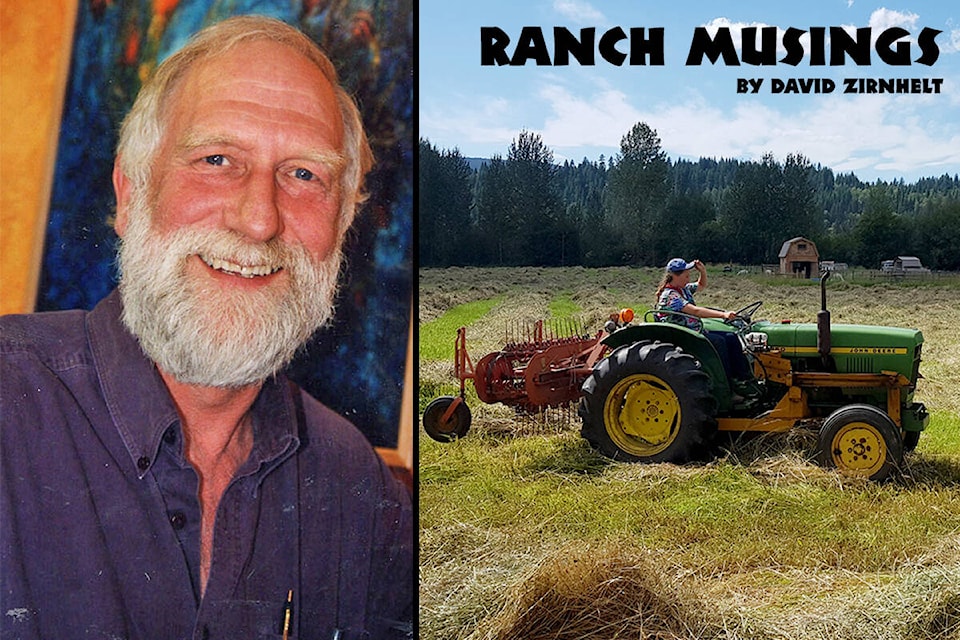We calve a little later than has been the practice of most ranches in the Cariboo, although later calving has become more popular in Western Canada. We have just moved our dwindling herd closer to home, picking a day when the footing was good so the mother cows heavy in calf would not risk falling and injuring themselves and their unborn calves.
Readers who have followed my last three articles will know that I have been looking back at the history of the development of ranching cattle (and horses to some extent) in our part of North America. I have been reading some of the many books about ranching, in particular the works of Ken Mather from the Central Okanagan (and until recently the curator of the historic O’Keefe Ranch in Vernon).
Ken has delved into the journals and memoirs of early settlers as well as newspaper articles about the lives of the traders, drovers, and settlers. He has, in my opinion, given fair treatment to the First Nations people (which he calls Native Indians) and the men and women of these nations.
When the gold rush surpassed the fur trade as the dominant economic activity the First Nations, who had adopted an extensive “horse culture” probably dating back to the mid 17th century, were well positioned to be providers of horsepower for travellers and traders and then to be the personnel for “droving” cattle.
The Indigenous knowledge of the land and its providence (food, clothing, shelter, etc.) set the first peoples up well for the marriage of the original culture and the newly arriving settlers. For at least the last 30 years, there has been a drastic reduction of the Indigenous participation in ranching as riders (cowboys and cowgirls), ranch owners, haying contractors, and homemakers.
Only recently has the purchase of ranches, into the hands of First Nations community “ownership” in some form, been rapidly developing. So far, however, the non-Indigenous consolidation of ranch land has exceeded that of the original peoples’ expansion.
The Douglas Lake Cattle Company now owns four of the biggest ranches in the Cariboo-Chilcotin. Douglas Lake Cattle Company, the parent company itself, is owned by an American who is the major land developer for the international Walmart chain.
These recent purchases have occurred at the same time as the reduction in the number of Indigenous employees (usually cowboys) at these ranches. In looking back and reading about Indigenous/settler relations, I understand that for the most part there was an accommodation between the cultures, often involving the unofficial marriage of First Nations women and the European men who were streaming into the country. In large part, it was probably the strength of women in Indigenous cultures that allowed this to happen. Unfortunately, as British Law and colonialism asserted itself in this new land without Indigenous consent, there followed an unhappy time. Land ownership went almost entirely to the newcomers and in time displaced much of the pasturing of horses and cattle by traditional people. Not because of the eventual emigration of European women, but somehow at the same time, some settlers looked down on their predecessors who had taken First Nations wives. With that condescension towards Aboriginal peoples, inevitably came attitudes based on race. The hurt created by the British and Canadian governments trying to stamp out Aboriginal culture added to the resentment towards the colonial occupiers.
As I have heard it in and around First Nations communities, it is the reduction of access to the land that they traditionally could travel through, enjoy, and harvest from that hurts the most.
When I look at my own motives for “ranching,” I see the beauty of the land I look after and love. I also see the bounty that the land provides as “economic” activity that gives us the security of shelter and food and spiritual sustenance.
And, when we walk among the livestock that are birthing, I know better the meaning of life on the land.
READ MORE: Freedom on the range
Do you have a comment about this story? email:
editor@wltribune.com
Like us on Facebook and follow us on Twitter.
